 W
WBASE jumping is the recreational sport of jumping from fixed objects, using a parachute to descend safely to the ground. "BASE" is an acronym that stands for four categories of fixed objects from which one can jump: buildings, antennae, spans (bridges), and earth (cliffs). Participants exit from a fixed object such as a cliff, and after an optional freefall delay, deploy a parachute to slow their descent and land. A popular form of BASE jumping is wingsuit BASE jumping.
 W
WBungee jumping, also spelt bungy jumping, is an activity that involves a person jumping from a great height while connected to a large elastic cord. The launching pad is usually erected on a tall structure such as a building or crane, a bridge across a deep ravine, or on a natural geographic feature such as a cliff. It is also possible to jump from a type of aircraft that has the ability to hover above the ground, such as a hot-air-balloon or helicopter. The thrill comes from the free-falling and the rebound. When the person jumps, the cord stretches and the jumper flies upwards again as the cord recoils, and continues to oscillate up and down until all the kinetic energy is dissipated.
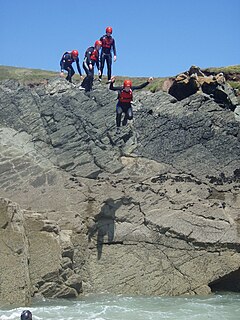 W
WCliff jumping is jumping off a cliff as a form of sport. When done without equipment, it may be also known as tombstoning. It forms part of the sport of coastal exploration or "coasteering". When performed with a parachute, it is known as BASE jumping. The world record for cliff jumping is currently held by Laso Schaller, with a jump of 58.8 m (193 ft).
 W
WDiving is the sport of jumping or falling into water from a platform or springboard, usually while performing acrobatics. Diving is an internationally recognized sport that is part of the Olympic Games. In addition, unstructured and non-competitive diving is a recreational pastime.
 W
WFigure skating jumps are an element of three competitive figure skating disciplines—men's singles, ladies' singles, and pair skating but not ice dancing. Jumping in figure skating is "relatively recent". They were originally individual compulsory figures, and sometimes special figures; many jumps were named after the skaters who invented them or from the figures from which they were developed. It was not until the early part of the twentieth century, well after the establishment of organized skating competitions, when jumps with the potential of being completed with multiple revolutions were invented and when jumps were formally categorized. In the 1920s, Austrian skaters began to perform the first double jumps in practice. Skaters experimented with jumps, and by the end of the period, the modern repertoire of jumps had been developed. Jumps did not have a major role in free skating programs during international competitions until the 1930s. During the post-war period and into the 1950s and early 1960s, triple jumps became more common for both male and female skaters, and a full repertoire of two-revolution jumps had been fully developed. In the 1980s, men were expected to complete four or five difficult triple jumps, and women had to perform the easier triples. By the 1990s, after compulsory figures were removed from competitions, multi-revolution jumps became more important in figure skating.
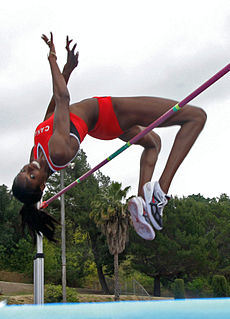 W
WThe high jump is a track and field event in which competitors must jump unaided over a horizontal bar placed at measured heights without dislodging it. In its modern, most-practiced format, a bar is placed between two standards with a crash mat for landing. Since ancient times, competitors have introduced increasingly effective techniques to arrive at the current form, in which athletes run towards the bar and use the Fosbury Flop method, leaping head first with their back to the bar.
 W
WIn basketball, a hook shot is a play in which the offensive player, usually turned perpendicular to the basket, gently throws the ball with a sweeping motion of the arm farther from the basket in an upward arc with a follow-through which ends over his head. Unlike the jump shot, it is shot with only one hand; the other arm is often used to create space between the shooter and the defensive player. The shot is quite difficult to block, but few players have mastered the shot more than a few feet from the basket.
 W
WHopscotch is a popular playground game in which players toss a small object into numbered triangles or a pattern of rectangles outlined on the ground and then hop or jump through the spaces and retrieve the object. It is a children's game that can be played with several players or alone.
 W
WHurdling is the act of jumping over an obstacle at a high speed or in a sprint. In the early 19th century, hurdlers ran at and jumped over each hurdle, landing on both feet and checking their forward motion. Today, the dominant step patterns are the 3-step for high hurdles, 7-step for low hurdles, and 15-step for intermediate hurdles. Hurdling is a highly specialized form of obstacle racing, and is part of the sport of athletics. In hurdling events, barriers known as hurdles are set at precisely measured heights and distances. Each athlete must pass over the hurdles; passing under or intentionally knocking over hurdles will result in disqualification.
 W
WA jump ball is a method used to begin or resume play in basketball. It is similar to a face-off in ice hockey and field lacrosse and a ball-up in Australian rules football. Two opposing players attempt to gain control of the ball after an official tosses it into the air between them.
 W
WA jumping jack, also known as a star jump and called a side-straddle hop in the US military, is a physical jumping exercise performed by jumping to a position with the legs spread wide and the hands going overhead, sometimes in a clap, and then returning to a position with the feet together and the arms at the sides.
 W
WThe long jump is a track and field event in which athletes combine speed, strength and agility in an attempt to leap as far as possible from a take off point. Along with the triple jump, the two events that measure jumping for distance as a group are referred to as the "horizontal jumps". This event has a history in the Ancient Olympic Games and has been a modern Olympic event for men since the first Olympics in 1896 and for women since 1948.
 W
WParkour is a training discipline where practitioners aim to get from one point to another in a complex environment, without assisting equipment and in the fastest and most efficient way possible. With roots in military obstacle course training and martial arts, parkour includes running, climbing, swinging, vaulting, jumping, plyometrics, rolling, and quadrupedal movement—whatever is suitable for the situation.
 W
WPole vaulting, also known as pole jumping, is a track and field event in which an athlete uses a long and flexible pole, usually made from fiberglass or carbon fiber, as an aid to jump over a bar. Pole jumping competitions were known to the ancient Greeks, Cretans and Celts. It has been a full medal event at the Olympic Games since 1896 for men and since 2000 for women.
 W
WThe sack race or potato sack race is a competitive game in which participants place both of their legs inside a sack or pillow case that reaches their waist or neck and hop forward from a starting point toward a finish line. The first person to cross the finish line is the winner of the race.
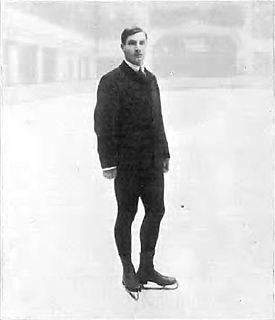 W
WThe Salchow jump is an edge jump in figure skating. It was named after its inventor, Ulrich Salchow, in 1909. The Salchow is accomplished with a takeoff from the back inside edge of one foot and a landing on the back outside edge of the opposite foot. It is "usually the first jump that skaters learn to double, and the first or second to triple". Timing is critical because both the takeoff and landing must be on the backward edge. A Salchow is deemed cheated if the skate blade starts to turn forward before the takeoff, or if it has not turned completely backward when the skater lands back on the ice.
 W
WSki jumping is a winter sport in which competitors aim to achieve the longest jump after descending from a specially designed ramp on their skis. Along with jump length, competitor's style and other factors affect the final score. Ski jumping was first contested in Norway in the late 19th century, and later spread through Europe and North America in the early 20th century. Along with cross-country skiing, it constitutes the traditional group of Nordic skiing disciplines.
 W
WSki-BASE jumping is the recreational sport of skiing at a high speed off of a cliff or mountain and free-falling through the air, using a parachute to descend to the ground, therefore combining the two sports of skiing and BASE jumping. Participants often perform tricks or manoeuvres during the freefall and remove their skis mid-air in order to safely deploy the parachute and land.
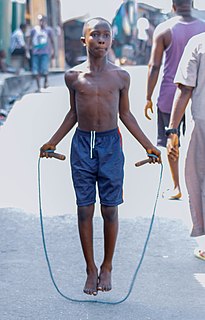 W
WA skipping rope or jump rope is a tool used in the sport of skipping/jump rope where one or more participants jump over a rope swung so that it passes under their feet and over their heads. There are multiple subsets of skipping/jump rope, including single freestyle, single speed, pairs, three-person speed, and three-person freestyle.
 W
WA split jump is a sequence of body movements in which a split is performed after jumping, while the performer is still in the air. Split jumps are commonly found in dance, figure skating, and gymnastics, and may also be used as a form of exercise.
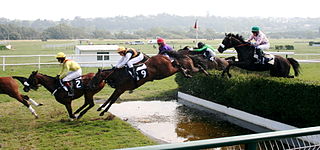 W
WA steeplechase is a distance horse race in which competitors are required to jump diverse fence and ditch obstacles. Steeplechasing is primarily conducted in Ireland, the United Kingdom, Canada, United States, Australia and France. The name is derived from early races in which orientation of the course was by reference to a church steeple, jumping fences and ditches and generally traversing the many intervening obstacles in the countryside.
 W
WTrampolining or trampoline gymnastics is a recreational activity, acrobatic training tool as well as a competitive Olympic sport in which athletes perform acrobatics while bouncing on a trampoline. In competition, these can include simple jumps in the straight, pike, tuck, or straddle position to more complex combinations of forward and/or backward somersaults and twists. Scoring is based on the difficulty and on the total seconds spent in the air. Points are deducted for bad form and horizontal displacement from the center of the bed.
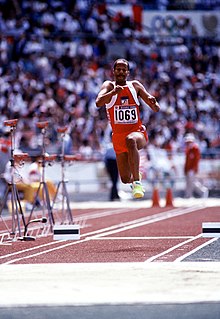 W
WThe triple jump, sometimes referred to as the hop, step and jump or the hop, skip and jump, is a track and field event, similar to the long jump. As a group, the two events are referred to as the "horizontal jumps". The competitor runs down the track and performs a hop, a bound and then a jump into the sand pit. The triple jump was inspired by the ancient Olympic Games and has been a modern Olympics event since the Games' inception in 1896.
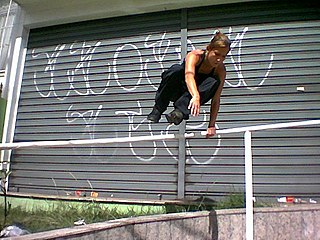 W
WIn various urban activities, a vault is any type of movement that involves overcoming an obstacle by some combination of jumping, climbing or diving. Although parkour doesn't involve the idea of set movements, practitioners use similar ways of moving to pass quickly and efficiently over obstacles.
 W
WA vertical jump or vertical leap is the act of jumping upwards into the air. It can be an exercise for building both endurance and strength, and is also a standard test for measuring athletic performance. It may also be referred to as a Sargent jump, named for Dudley Allen Sargent.
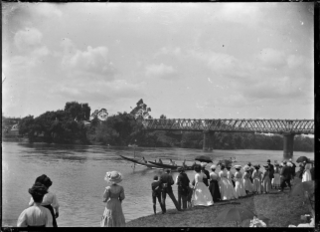 W
WWaka hurdling, also sometimes called waka peke, is a Maori sporting competition of jumping unornamented river canoes over wooden beams set in the water. There have been attempts to revive the sport and keep the tradition going. The Auckland Museum has a photograph of the sport and spectators. The hurdles are made of long tree branches. Albert Percy Godber photographed the sport in 1910. The competition is part of the festivities of traditional Maori regattas.